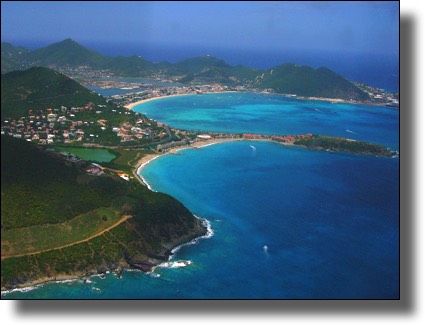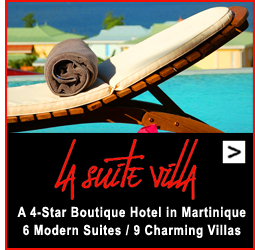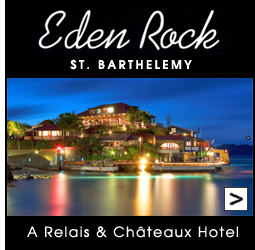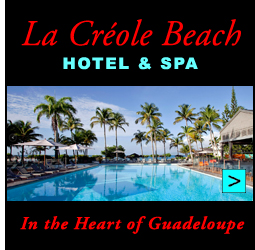St. Martin / St. Maarten - Description, Beaches, History
One of the most popular destinations in the Caribbean, French Saint Martin and Dutch Sint Maarten share one easily accessible island. It is always a favorite stop for cruise ships and its renovated airport is an international hub, welcoming a constant stream of travelers from around the world.

Visitors to St. Martin / St. Maarten discover more than thirty exceptional beaches, rolling hills, celebrated restaurants and lots of duty-free shopping. In addition to lively casinos and colorful markets, the island offers fascinating art galleries and interesting historical sites.
There are no customs formalities between the Dutch and French sides. The boundaries are simply marked by "welcome'' signs on each side. The French side, St. Martin, offers exceptional French and Créole cuisine to complement its delightful French style and joie de vivre.
Accommodations range from super-luxury hotels and villas to simple inns and bungalows. A vast range of land and water activities add to the allure of this inviting and multi-dimensional island.
The towns on the French side have a beguiling West Indian charm combined with certain distinct touches of France: open markets that are typically Caribbean, bakeries that are typically French and seaside cafes that seem to have been transplanted intact from the Côte d'Azur.
The capital of Marigot is no longer the sleepy little fishing village it once was. It has awakened to tourism, with great restaurants, fashionable boutiques and a full-featured waterfront, marina and pier. In the north, the lovely village of Grand Case is famous for its exceptional restaurants. On the east coast, Orient Bay is popular for its casual atmosphere and beachside activities.
The capital and main city on the Dutch side, Philipsburg, lies on a narrow strip of land between the Great Salt Pond to the north and Great Bay to the south. Lovely old colonial style houses with "gingerbread" fretwork mingle with the duty-free shops, restaurants, cafes and nightclubs lining the two main thoroughfares, Front Street and Back Street. By day and night, the town attracts cruise ship passengers and other island visitors to its many and varied attractions.
Maho Bay, adjacent to the international airport at the southern edge of the Simpson Bay Lagoon, is another center of activity with shops, casinos, restaurants and a number of resort hotels.
The terrain is a generally pastoral green with soft, rolling hills. The western portion includes Simpson Bay Lagoon with its calm waters and numerous water sports centers. The highest mountain, called Paradise Peak (Pic du Paradis), rises to almost 424 m (1,391 ft) and there are many forested heights in the center of the island. The coastline is set with deep coves and bays and an abundance of sensational beaches encircles the island. The waters are unusually clear, and snorkelers can spot brilliantly colored fish at up to 10 m (30 ft) or more.
Situated at the northern point of the Guadeloupe Archipelago, the island is 2805 km (1,683 mi) south of New York and 240 km (144 mi) east of Puerto Rico. The total land area is 92.5 sq km (37 sq mi). The southern half, Dutch Sint Maarten, is 42 sq km (16 sq mi); the northern half, French St. Martin, is 52.5 sq km (21 sq mi); The total population of St. Maarten / St. Martin is approximately 77,000.
French St. Martin is an official French Collectivité d’Outre-Mer (COM) and, as such, is part of the European Union. It is administered locally by an elected Président and territorial council. Dutch St. Maarten was restructured in 2010 as a separate country within the Kingdom of the Netherlands.
BEACHES
Saint Martin (St. Martin / St. Maarten) has a wealth of beautiful beaches with many of the finest ones on the French side of the island. Baie Longue (Long Bay), is a magnificent arc of white sand with calm, clear waters located at the western-most edge of the island's north shore. It enjoys an isolated location in Terres Basses with the luxurious La Samanna hotel on its eastern end. Baie aux Prunes (Plum Bay) also on the far western edge of Terres Basses, is reachable by walking west around Pointe du Canonnier, is small and shady with good surfing close to the rocks.
Baie Rouge (Red Bay) is a gorgeous stretch of sand on the northern shore of Terres Basses with a snack bar and umbrella rental near the entrance. Baie Nettlé stretches from Terres Basses to Marigot Bay, with restaurants, seaside hotels and a few watersports operations. Friar's Bay, just west of Grand Case, is pretty and very popular with St. Martin locals and divers attracted by the beauty of its coral reef.
Grand Case, an impressive arc of crystal-clear water and white sand, is very calm for swimming and snorkeling and offers excellent beachfront restaurants. Anse Marcel is calm and quiet, nicely shady, and great for kids, with hotels nearby. Petites Cayes, the most isolated beach on St. Martin, can by accessed by boat or a 20 minute walk via a coastal trail from Cul-de-Sac.
Located on the northeast coast, Cul-de-Sac is a scenic beach with boats shuttling back and forth to the offshore islets, Pinel Island and Tintamarre. Orient Bay includes a spectacular stretch of white sand, with a clothing-optional section, numerous dining spots, beach shops and watersports. It can be very breezy at times. Baie de l'Embouchure, protected by a coral barrier, is nice for sailing and windsurfing. Baie Lucas offers good diving from its isolated beach on the east coast.
All beaches on the French side of the island are public, and topless sunbathing for women is generally acceptable.
A BRIEF HISTORY
Archaeologists have investigated more than 30 pre-Colombian settlements on St. Martin / St. Maarten. Indigenous peoples, including the peaceful Arawaks and the fierce Caribs, populated the island as early as 2000 B.C.
The French and Dutch nations have coexisted peacefully on the island for three centuries. According to a colorful legend, the boundaries were established in a walking contest in 1648 in which the Frenchmen paced off the larger share of the island.
Columbus arrived and named the island in 1493, and in the 1630's the French and Dutch both settled on the island. In the early days the island was a pirates' haven with the island's many coves and bays used as hiding places. It was in St. Maarten that Peter Stuyvesant (the last Dutch governor of New York) lost his leg in a struggle with the Spanish in 1640.
As was the case with much of the Caribbean, the cultivation of sugar cane introduced slavery to the island. The French abolished slavery in 1848, and the Dutch slaves were emancipated 15 years later. After a prolonged depression, the island was declared a duty-free port in 1939. Today, tourism is the leading factor in the economy of this beautiful and multicultural island.
There are no customs formalities between the Dutch and French sides. The boundaries are simply marked by "welcome'' signs on each side. The French side, St. Martin, offers exceptional French and Créole cuisine to complement its delightful French style and joie de vivre.
Accommodations range from super-luxury hotels and villas to simple inns and bungalows. A vast range of land and water activities add to the allure of this inviting and multi-dimensional island.
The towns on the French side have a beguiling West Indian charm combined with certain distinct touches of France: open markets that are typically Caribbean, bakeries that are typically French and seaside cafes that seem to have been transplanted intact from the Côte d'Azur.
The capital of Marigot is no longer the sleepy little fishing village it once was. It has awakened to tourism, with great restaurants, fashionable boutiques and a full-featured waterfront, marina and pier. In the north, the lovely village of Grand Case is famous for its exceptional restaurants. On the east coast, Orient Bay is popular for its casual atmosphere and beachside activities.
The capital and main city on the Dutch side, Philipsburg, lies on a narrow strip of land between the Great Salt Pond to the north and Great Bay to the south. Lovely old colonial style houses with "gingerbread" fretwork mingle with the duty-free shops, restaurants, cafes and nightclubs lining the two main thoroughfares, Front Street and Back Street. By day and night, the town attracts cruise ship passengers and other island visitors to its many and varied attractions.
Maho Bay, adjacent to the international airport at the southern edge of the Simpson Bay Lagoon, is another center of activity with shops, casinos, restaurants and a number of resort hotels.
The terrain is a generally pastoral green with soft, rolling hills. The western portion includes Simpson Bay Lagoon with its calm waters and numerous water sports centers. The highest mountain, called Paradise Peak (Pic du Paradis), rises to almost 424 m (1,391 ft) and there are many forested heights in the center of the island. The coastline is set with deep coves and bays and an abundance of sensational beaches encircles the island. The waters are unusually clear, and snorkelers can spot brilliantly colored fish at up to 10 m (30 ft) or more.
Situated at the northern point of the Guadeloupe Archipelago, the island is 2805 km (1,683 mi) south of New York and 240 km (144 mi) east of Puerto Rico. The total land area is 92.5 sq km (37 sq mi). The southern half, Dutch Sint Maarten, is 42 sq km (16 sq mi); the northern half, French St. Martin, is 52.5 sq km (21 sq mi); The total population of St. Maarten / St. Martin is approximately 77,000.
French St. Martin is an official French Collectivité d’Outre-Mer (COM) and, as such, is part of the European Union. It is administered locally by an elected Président and territorial council. Dutch St. Maarten was restructured in 2010 as a separate country within the Kingdom of the Netherlands.
BEACHES
Saint Martin (St. Martin / St. Maarten) has a wealth of beautiful beaches with many of the finest ones on the French side of the island. Baie Longue (Long Bay), is a magnificent arc of white sand with calm, clear waters located at the western-most edge of the island's north shore. It enjoys an isolated location in Terres Basses with the luxurious La Samanna hotel on its eastern end. Baie aux Prunes (Plum Bay) also on the far western edge of Terres Basses, is reachable by walking west around Pointe du Canonnier, is small and shady with good surfing close to the rocks.
Baie Rouge (Red Bay) is a gorgeous stretch of sand on the northern shore of Terres Basses with a snack bar and umbrella rental near the entrance. Baie Nettlé stretches from Terres Basses to Marigot Bay, with restaurants, seaside hotels and a few watersports operations. Friar's Bay, just west of Grand Case, is pretty and very popular with St. Martin locals and divers attracted by the beauty of its coral reef.
Grand Case, an impressive arc of crystal-clear water and white sand, is very calm for swimming and snorkeling and offers excellent beachfront restaurants. Anse Marcel is calm and quiet, nicely shady, and great for kids, with hotels nearby. Petites Cayes, the most isolated beach on St. Martin, can by accessed by boat or a 20 minute walk via a coastal trail from Cul-de-Sac.
Located on the northeast coast, Cul-de-Sac is a scenic beach with boats shuttling back and forth to the offshore islets, Pinel Island and Tintamarre. Orient Bay includes a spectacular stretch of white sand, with a clothing-optional section, numerous dining spots, beach shops and watersports. It can be very breezy at times. Baie de l'Embouchure, protected by a coral barrier, is nice for sailing and windsurfing. Baie Lucas offers good diving from its isolated beach on the east coast.
All beaches on the French side of the island are public, and topless sunbathing for women is generally acceptable.
A BRIEF HISTORY
Archaeologists have investigated more than 30 pre-Colombian settlements on St. Martin / St. Maarten. Indigenous peoples, including the peaceful Arawaks and the fierce Caribs, populated the island as early as 2000 B.C.
The French and Dutch nations have coexisted peacefully on the island for three centuries. According to a colorful legend, the boundaries were established in a walking contest in 1648 in which the Frenchmen paced off the larger share of the island.
Columbus arrived and named the island in 1493, and in the 1630's the French and Dutch both settled on the island. In the early days the island was a pirates' haven with the island's many coves and bays used as hiding places. It was in St. Maarten that Peter Stuyvesant (the last Dutch governor of New York) lost his leg in a struggle with the Spanish in 1640.
As was the case with much of the Caribbean, the cultivation of sugar cane introduced slavery to the island. The French abolished slavery in 1848, and the Dutch slaves were emancipated 15 years later. After a prolonged depression, the island was declared a duty-free port in 1939. Today, tourism is the leading factor in the economy of this beautiful and multicultural island.

Visitors to St. Martin / St. Maarten discover more than thirty exceptional beaches, rolling hills, celebrated restaurants and lots of duty-free shopping. In addition to lively casinos and colorful markets, the island offers fascinating art galleries and interesting historical sites.
There are no customs formalities between the Dutch and French sides. The boundaries are simply marked by "welcome'' signs on each side. The French side, St. Martin, offers exceptional French and Créole cuisine to complement its delightful French style and joie de vivre.
Accommodations range from super-luxury hotels and villas to simple inns and bungalows. A vast range of land and water activities add to the allure of this inviting and multi-dimensional island.
The towns on the French side have a beguiling West Indian charm combined with certain distinct touches of France: open markets that are typically Caribbean, bakeries that are typically French and seaside cafes that seem to have been transplanted intact from the Côte d'Azur.
The capital of Marigot is no longer the sleepy little fishing village it once was. It has awakened to tourism, with great restaurants, fashionable boutiques and a full-featured waterfront, marina and pier. In the north, the lovely village of Grand Case is famous for its exceptional restaurants. On the east coast, Orient Bay is popular for its casual atmosphere and beachside activities.
The capital and main city on the Dutch side, Philipsburg, lies on a narrow strip of land between the Great Salt Pond to the north and Great Bay to the south. Lovely old colonial style houses with "gingerbread" fretwork mingle with the duty-free shops, restaurants, cafes and nightclubs lining the two main thoroughfares, Front Street and Back Street. By day and night, the town attracts cruise ship passengers and other island visitors to its many and varied attractions.
Maho Bay, adjacent to the international airport at the southern edge of the Simpson Bay Lagoon, is another center of activity with shops, casinos, restaurants and a number of resort hotels.
The terrain is a generally pastoral green with soft, rolling hills. The western portion includes Simpson Bay Lagoon with its calm waters and numerous water sports centers. The highest mountain, called Paradise Peak (Pic du Paradis), rises to almost 424 m (1,391 ft) and there are many forested heights in the center of the island. The coastline is set with deep coves and bays and an abundance of sensational beaches encircles the island. The waters are unusually clear, and snorkelers can spot brilliantly colored fish at up to 10 m (30 ft) or more.
Situated at the northern point of the Guadeloupe Archipelago, the island is 2805 km (1,683 mi) south of New York and 240 km (144 mi) east of Puerto Rico. The total land area is 92.5 sq km (37 sq mi). The southern half, Dutch Sint Maarten, is 42 sq km (16 sq mi); the northern half, French St. Martin, is 52.5 sq km (21 sq mi); The total population of St. Maarten / St. Martin is approximately 77,000.
French St. Martin is an official French Collectivité d’Outre-Mer (COM) and, as such, is part of the European Union. It is administered locally by an elected Président and territorial council. Dutch St. Maarten was restructured in 2010 as a separate country within the Kingdom of the Netherlands.
BEACHES
Saint Martin (St. Martin / St. Maarten) has a wealth of beautiful beaches with many of the finest ones on the French side of the island. Baie Longue (Long Bay), is a magnificent arc of white sand with calm, clear waters located at the western-most edge of the island's north shore. It enjoys an isolated location in Terres Basses with the luxurious La Samanna hotel on its eastern end. Baie aux Prunes (Plum Bay) also on the far western edge of Terres Basses, is reachable by walking west around Pointe du Canonnier, is small and shady with good surfing close to the rocks.
Baie Rouge (Red Bay) is a gorgeous stretch of sand on the northern shore of Terres Basses with a snack bar and umbrella rental near the entrance. Baie Nettlé stretches from Terres Basses to Marigot Bay, with restaurants, seaside hotels and a few watersports operations. Friar's Bay, just west of Grand Case, is pretty and very popular with St. Martin locals and divers attracted by the beauty of its coral reef.
Grand Case, an impressive arc of crystal-clear water and white sand, is very calm for swimming and snorkeling and offers excellent beachfront restaurants. Anse Marcel is calm and quiet, nicely shady, and great for kids, with hotels nearby. Petites Cayes, the most isolated beach on St. Martin, can by accessed by boat or a 20 minute walk via a coastal trail from Cul-de-Sac.
Located on the northeast coast, Cul-de-Sac is a scenic beach with boats shuttling back and forth to the offshore islets, Pinel Island and Tintamarre. Orient Bay includes a spectacular stretch of white sand, with a clothing-optional section, numerous dining spots, beach shops and watersports. It can be very breezy at times. Baie de l'Embouchure, protected by a coral barrier, is nice for sailing and windsurfing. Baie Lucas offers good diving from its isolated beach on the east coast.
All beaches on the French side of the island are public, and topless sunbathing for women is generally acceptable.
A BRIEF HISTORY
Archaeologists have investigated more than 30 pre-Colombian settlements on St. Martin / St. Maarten. Indigenous peoples, including the peaceful Arawaks and the fierce Caribs, populated the island as early as 2000 B.C.
The French and Dutch nations have coexisted peacefully on the island for three centuries. According to a colorful legend, the boundaries were established in a walking contest in 1648 in which the Frenchmen paced off the larger share of the island.
Columbus arrived and named the island in 1493, and in the 1630's the French and Dutch both settled on the island. In the early days the island was a pirates' haven with the island's many coves and bays used as hiding places. It was in St. Maarten that Peter Stuyvesant (the last Dutch governor of New York) lost his leg in a struggle with the Spanish in 1640.
As was the case with much of the Caribbean, the cultivation of sugar cane introduced slavery to the island. The French abolished slavery in 1848, and the Dutch slaves were emancipated 15 years later. After a prolonged depression, the island was declared a duty-free port in 1939. Today, tourism is the leading factor in the economy of this beautiful and multicultural island.
________________________________________
French Caribbean International has been the premier guide to the French West Indies since 1994. We provide a wealth of helpful travel information for visitors to the Caribbean islands of St. Barthélemy (St. Barts, St. Barth, St. Barths), St. Martin / St. Maarten, Martinique, Guadeloupe, Les Saintes and Marie-Galante.







